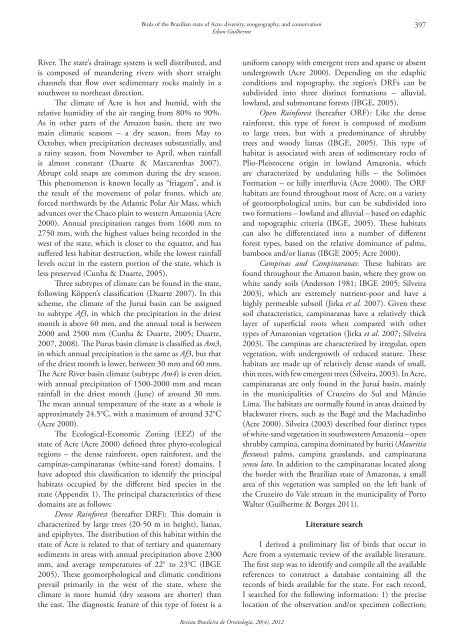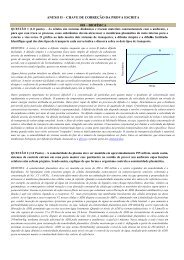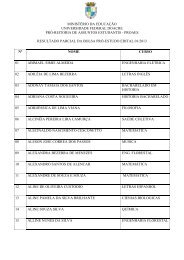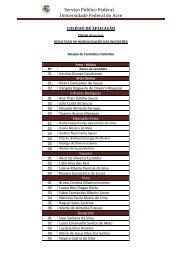Revista Brasileira de Ornitologia - Universidade Federal do Acre
Revista Brasileira de Ornitologia - Universidade Federal do Acre
Revista Brasileira de Ornitologia - Universidade Federal do Acre
Create successful ePaper yourself
Turn your PDF publications into a flip-book with our unique Google optimized e-Paper software.
Birds of the Brazilian state of <strong>Acre</strong>: diversity, zoogeography, and conservationEdson Guilherme397River. The state’s drainage system is well distributed, andis composed of mean<strong>de</strong>ring rivers with short straightchannels that flow over sedimentary rocks mainly in asouthwest to northeast direction.The climate of <strong>Acre</strong> is hot and humid, with therelative humidity of the air ranging from 80% to 90%.As in other parts of the Amazon basin, there are twomain climatic seasons – a dry season, from May toOctober, when precipitation <strong>de</strong>creases substantially, anda rainy season, from November to April, when rainfallis almost constant (Duarte & Marcarenhas 2007).Abrupt cold snaps are common during the dry season.This phenomenon is known locally as “friagem”, and isthe result of the movement of polar fronts, which areforced northwards by the Atlantic Polar Air Mass, whichadvances over the Chaco plain to western Amazonia (<strong>Acre</strong>2000). Annual precipitation ranges from 1600 mm to2750 mm, with the highest values being recor<strong>de</strong>d in thewest of the state, which is closer to the equator, and hassuffered less habitat <strong>de</strong>struction, while the lowest rainfalllevels occur in the eastern portion of the state, which isless preserved (Cunha & Duarte, 2005).Three subtypes of climate can be found in the state,following Köppen’s classification (Duarte 2007). In thisscheme, the climate of the Juruá basin can be assignedto subtype Af3, in which the precipitation in the driestmonth is above 60 mm, and the annual total is between2000 and 2500 mm (Cunha & Duarte, 2005; Duarte,2007, 2008). The Purus basin climate is classified as Am3,in which annual precipitation is the same as Af3, but thatof the driest month is lower, between 30 mm and 60 mm.The <strong>Acre</strong> River basin climate (subtype Am4) is even drier,with annual precipitation of 1500-2000 mm and meanrainfall in the driest month (June) of around 30 mm.The mean annual temperature of the state as a whole isapproximately 24.5°C, with a maximum of around 32°C(<strong>Acre</strong> 2000).The Ecological-Economic Zoning (EEZ) of thestate of <strong>Acre</strong> (<strong>Acre</strong> 2000) <strong>de</strong>fined three phyto-ecologicalregions – the <strong>de</strong>nse rainforest, open rainforest, and thecampinas-campinaranas (white-sand forest) <strong>do</strong>mains. Ihave a<strong>do</strong>pted this classification to i<strong>de</strong>ntify the principalhabitats occupied by the different bird species in thestate (Appendix 1). The principal characteristics of these<strong>do</strong>mains are as follows:Dense Rainforest (hereafter DRF): This <strong>do</strong>main ischaracterized by large trees (20-50 m in height), lianas,and epiphytes. The distribution of this habitat within thestate of <strong>Acre</strong> is related to that of tertiary and quaternarysediments in areas with annual precipitation above 2300mm, and average temperatures of 22° to 23°C (IBGE2005). These geomorphological and climatic conditionsprevail primarily in the west of the state, where theclimate is more humid (dry seasons are shorter) thanthe east. The diagnostic feature of this type of forest is auniform canopy with emergent trees and sparse or absentun<strong>de</strong>rgrowth (<strong>Acre</strong> 2000). Depending on the edaphicconditions and topography, the region’s DRFs can besubdivi<strong>de</strong>d into three distinct formations – alluvial,lowland, and submontane forests (IBGE, 2005).Open Rainforest (hereafter ORF): Like the <strong>de</strong>nserainforest, this type of forest is composed of mediumto large trees, but with a pre<strong>do</strong>minance of shrubbytrees and woody lianas (IBGE, 2005). This type ofhabitat is associated with areas of sedimentary rocks ofPlio-Pleistocene origin in lowland Amazonia, whichare characterized by undulating hills – the SolimõesFormation – or hilly interfluvia (<strong>Acre</strong> 2000). The ORFhabitats are found throughout most of <strong>Acre</strong>, on a varietyof geomorphological units, but can be subdivi<strong>de</strong>d intotwo formations – lowland and alluvial – based on edaphicand topographic criteria (IBGE, 2005). These habitatscan also be differentiated into a number of differentforest types, based on the relative <strong>do</strong>minance of palms,bamboos and/or lianas (IBGE 2005; <strong>Acre</strong> 2000).Campinas and Campinaranas: These habitats arefound throughout the Amazon basin, where they grow onwhite sandy soils (An<strong>de</strong>rson 1981; IBGE 2005; Silveira2003), which are extremely nutrient-poor and have ahighly permeable subsoil (Jirka et al. 2007). Given thesesoil characteristics, campinaranas have a relatively thicklayer of superficial roots when compared with othertypes of Amazonian vegetation (Jirka et al. 2007; Silveira2003). The campinas are characterized by irregular, openvegetation, with un<strong>de</strong>rgrowth of reduced stature. Thesehabitats are ma<strong>de</strong> up of relatively <strong>de</strong>nse stands of small,thin trees, with few emergent trees (Silveira, 2003). In <strong>Acre</strong>,campinaranas are only found in the Juruá basin, mainlyin the municipalities of Cruzeiro <strong>do</strong> Sul and MâncioLima. The habitats are normally found in areas drained byblackwater rivers, such as the Bagé and the Machadinho(<strong>Acre</strong> 2000). Silveira (2003) <strong>de</strong>scribed four distinct typesof white-sand vegetation in southwestern Amazonia – openshrubby campina, campina <strong>do</strong>minated by buriti (Mauritiaflexuosa) palms, campina grasslands, and campinaranasensu lato. In addition to the campinaranas located alongthe bor<strong>de</strong>r with the Brazilian state of Amazonas, a smallarea of this vegetation was sampled on the left bank ofthe Cruzeiro <strong>do</strong> Vale stream in the municipality of PortoWalter (Guilherme & Borges 2011).Literature searchI <strong>de</strong>rived a preliminary list of birds that occur in<strong>Acre</strong> from a systematic review of the available literature.The first step was to i<strong>de</strong>ntify and compile all the availablereferences to construct a database containing all therecords of birds available for the state. For each record,I searched for the following information: 1) the preciselocation of the observation and/or specimen collection;<strong>Revista</strong> <strong>Brasileira</strong> <strong>de</strong> <strong>Ornitologia</strong>, 20(4), 2012










